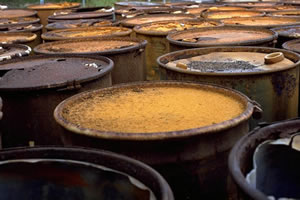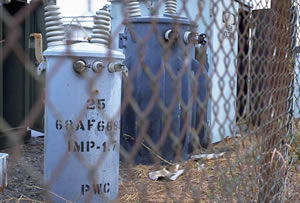- Constructivism
- PBL as an Example
of CLE
- Prototype as a
PBL
- References
Prototype
 The
problem defined: The US military
produces environmental contamination in every major domestic and foreign
base. In the 1980s, the General Accounting Office of the US Congress found
the US military to be one of the worst violators of environmental laws.
Since then, legislation has been passed and domestic cleanup programs
initiated to minimize the threat from military bases to public health
and the environment. In Europe and other countries, law suits were filed
forcing the US military to clean up.
The
problem defined: The US military
produces environmental contamination in every major domestic and foreign
base. In the 1980s, the General Accounting Office of the US Congress found
the US military to be one of the worst violators of environmental laws.
Since then, legislation has been passed and domestic cleanup programs
initiated to minimize the threat from military bases to public health
and the environment. In Europe and other countries, law suits were filed
forcing the US military to clean up.
After nearly a century of military operations in the Philippines, the US military left behind sites contaminated with toxic solvents, pesticides, asbestos, heavy metals, unexploded ordnance and other hazardous substances. Serious groundwater and soil contamination in over 46 sites on Clark and Subic is documented in reports by the US General Accounting Office (GAO), World Health Organization, Independent US and Philippine experts, two US-based environmental firms, and the Department of Defense's internal reports. US failure to meet its environmental safety standards is also documented by the GAO. Yet, US officials refuse to even acknowledge the problem.
 The
health effects of some of these hazardous wastes are readily seen, as
in those victims suffering from asbestosis or wounds from detonated ammunition.
The health effects of other waste materials such as lead, mercury, polychlorinated
biphenyls (PCBs) and other persistent organic pollutants are less discernible
but equally deadly.These substances have been linked to reproductive failure,
cancers, and behavioral disorders.Former Clark residents report many cases
of stillbirths, birth defects, cancers, skin problems, and mental disability.
Some Clark residents still drink from wells testing positive for mercury.
A preliminary health survey, released in 1998, shows that communities
closest to toxic sites report higher rates of reproductive, kidney, and
nervous system disorders. Many leukemia cases have been diagnosed among
children and as many as 81 people have died.
The
health effects of some of these hazardous wastes are readily seen, as
in those victims suffering from asbestosis or wounds from detonated ammunition.
The health effects of other waste materials such as lead, mercury, polychlorinated
biphenyls (PCBs) and other persistent organic pollutants are less discernible
but equally deadly.These substances have been linked to reproductive failure,
cancers, and behavioral disorders.Former Clark residents report many cases
of stillbirths, birth defects, cancers, skin problems, and mental disability.
Some Clark residents still drink from wells testing positive for mercury.
A preliminary health survey, released in 1998, shows that communities
closest to toxic sites report higher rates of reproductive, kidney, and
nervous system disorders. Many leukemia cases have been diagnosed among
children and as many as 81 people have died.
It is unconscionable that the US, with full knowledge of the danger of military contamination and while willing to protect those in developed countries, is unwilling to help the Philippines, a country with few financial and technical resources to conduct a comprehensive cleanup. This US refusal to protect health violates international law. Filipino Americans can rectify this environmental injustice by pressuring the US government to meet its moral and legal obligations to protect health.
When the U.S. military closed down its bases in the Philippines in 1992, they left behind toxic contamination that is now seeping into the environment, threatening the lives of thousands of people in surrounding communities. Today, more than one hundred people have died from illnesses believed to be linked to the toxic waste. Despite calls by community and environmental groups for U.S. accountability, the United States refuses to take responsibility for this environmental tragedy.
Who is going to clean up the toxic wastes left at the former military bases in the Philippines, how is it going to be cleaned up, and how is the environmental health of the people in these affected communities in and surrounding the former bases going to be protected?